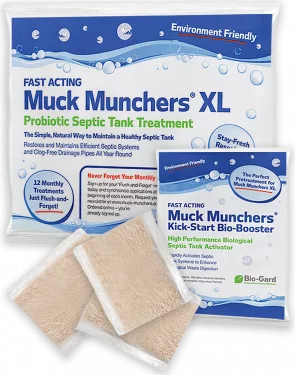Septic Systems
What are Septic Systems?
Septic systems are underground, they process sewage and wastewater from homes that are not connected to a main sewage system. Predominantly, these properties are older in age and/or found in rural locations. The main purpose of septic systems is to enable the safe sewage digestion and disposal of wastewater.
Septic systems work via a series of inlet and outlet pipes, a tank with several chambers and a soakaway.
Most septic tanks comprise two chambers, though it’s not uncommon for some systems to incorporate three or more. Newer septic systems, often referred to as Package Sewage Treatment Plants, mostly rely on electrical power to improve aeration to enhance the rate of organic waste digestion.
In very simple terms, organic waste matter is flushed or drained from toilets, baths, showers, sinks and basins into an underground septic tank. Once the wastewater and organic matter has entered the tank it separates into three – solids, effluent and scum.
- Solids – these settle at the bottom of your tank in a sludge-like mass. These solids are both bio-digestible organic and inorganic solids.
- Effluent – this is mainly water, containing digestible organic matter and fills the bulk of your tank. It is the middle layer and is where the microbes are highly active.
- Scum – floats up to the top and sits on the surface of the effluent. This is predominantly made up of fats, oils and greases (FOG).
Inlet pipes enable the wastewater to enter the tank from the property. Outlet pipes allow treated wastewater to flow into the drainfield / soakaway.
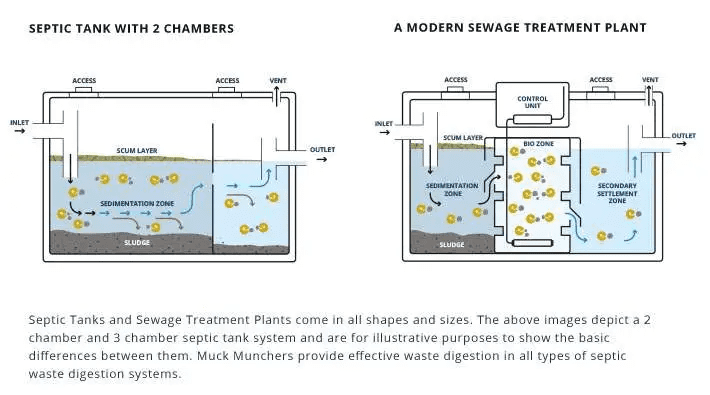
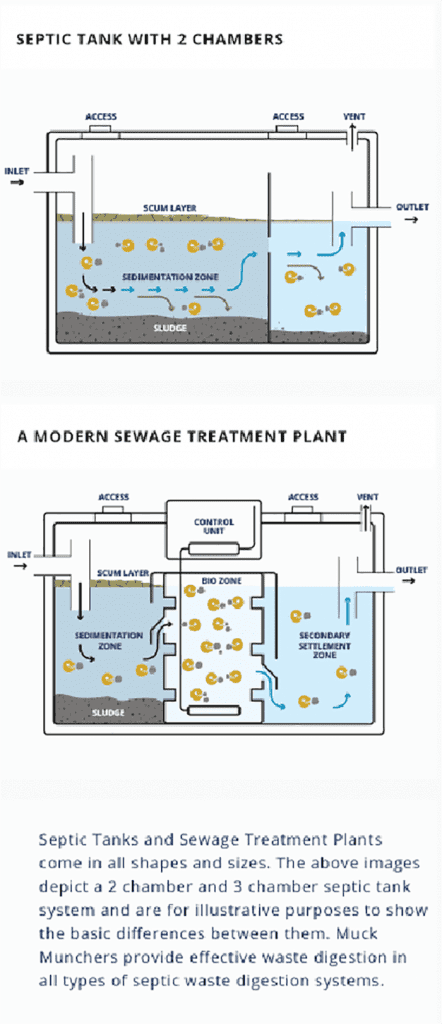
Septic Systems work by processing the solids and Wastewater from your home, through to your drainage system and into your septic tank. It then goes through a biological process to decompose the solid matter produced from bathrooms, kitchens and your laundry, to clean the water before it enters your soakaway and into the environment.
Septic systems have soakaways, also known as a drainfields or leach fields. Treated effluent waste flows from the first septic tank chamber to the secondary chamber(s), then through a drain to the soakaway. The soakaway lays underground about 50-90cm deep, and is typically a fan or herringbone arrangement of multiple ‘perforated’ pipes.
A blockage is a sign of a problem soakaway. This occurs when the effluent waste is unable to freely flow.
Signs of a blocked soakaway include:
- Waterlogged and boggy grass areas
- Foul odours from tanks and / or drains
- Slow draining toilets, sinks and baths
What’s a Bad Septic Tank?
A bad septic tank is one that has become inactive. The result:
- Foul Smells
- Drains Blocking or Backing-up
- Effluent Overflows
- Wet Boggy Soakaway Areas
- Potentially Damaged Soakaway
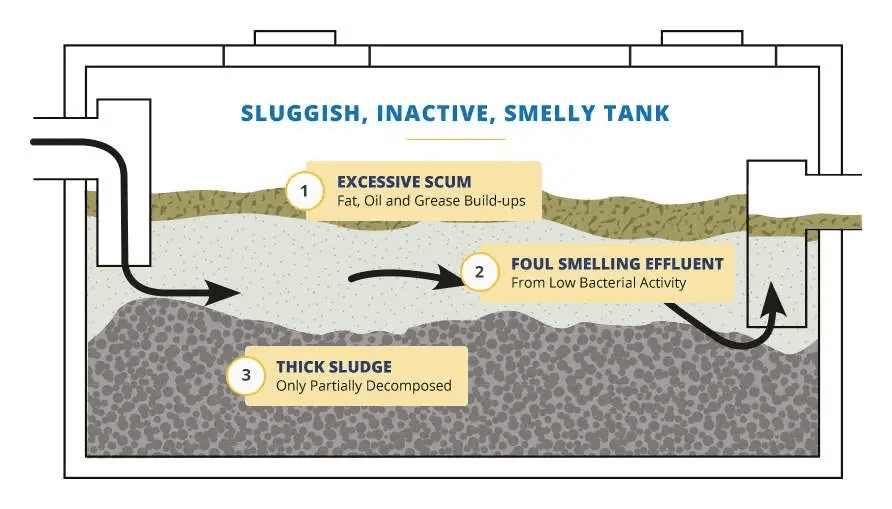
The natural digestion process in your tank can easily be disrupted if the natural enzyme-producing bacteria are destroyed by detergents, antibiotics, chlorine bleaches, antibacterial products and other contaminants. Find out what you shouldn’t flush into your septic system to ensure natural-producing bacteria are not destroyed.
Inactivity leads to tank stagnation resulting in septic system failures. This occurs when healthy aerobic bacteria die or become anaerobic, leading to build-ups of fats, oils and greases, excessive sludge, foul smells and blockages causing overflows.
A bad septic tank can lead to soakaway problems too. Untreated effluent entering the soakaway areas can result in water-logged grounds and potentially the need to completely relay the soakaway drain network, which can be extremely costly and ruin otherwise attractive garden landscapes.
Emptying septic tanks is costly and provides no long-term solution, while blocked soakaway outflow drains can cost £’thousands to replace which is why its important to care for your septic tank system
What’s a Good Septic Tank?
A good septic tank is one that is healthy and active. The result:
- No foul smells or odours
- Minimal chances of blocked drains
- Effective waste digestion so no overflows
- Purer outflows to keep soakaways aerobic
- Fewer expensive pump-outs
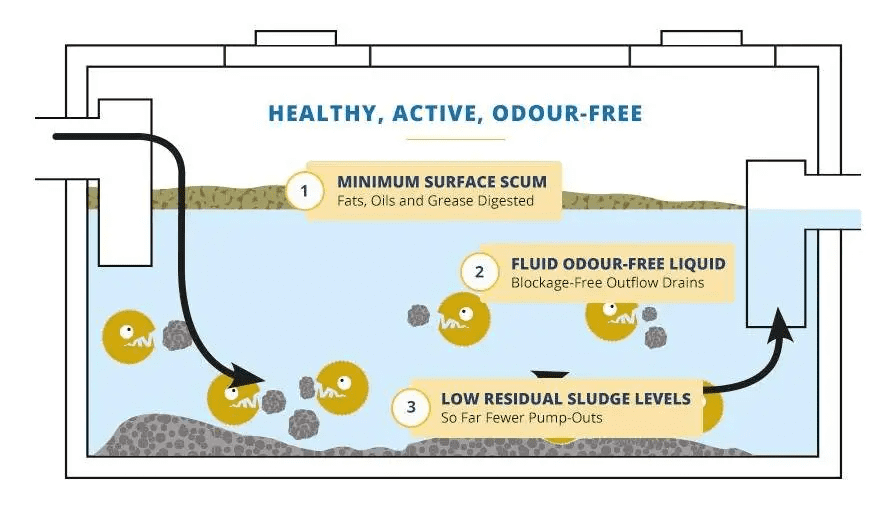
In a healthy septic system the bacteria will be actively digesting the fats, oils and greases of the Scum Layer floating at the top of your tank. Its appearance will be a thin bubbly layer of light organic frothy bubbles.
The middle section of your tank, the effluent layer (liquid), will be relatively clear due to the healthy movement of fluid. This is the sign of lots of bacterial activity. The purer, clearer liquid exits via an outlet drain pipe into the soakaway, resulting in minimal chances of soakaway blockages and lower effluent discharges to the soil environment.
The sludge layer at the bottom of your tank is where the inorganic material and byproducts of bacterial digestion sit. If your septic system is healthy you will have very low levels of organic sludge material. The result is a significant reduction in build-ups, fewer pump-outs and less chance of soakaway problems.
The key to success is to maintain a healthy aerobic bacterial population in the tank, to ensure that there are high levels of organic waste digestion.
To do this you need to understand what not to flush into your septic system. The input of fats, oils and greases along with common household chemicals and cleaning products including bleaches into your septic system will weaken and may even destroy healthy populations of bacteria in your tank.
In addition, using Muck Munchers biological septic tank cleaners will promote an overall aerobic septic system and increase the good bacteria in your tank.
How THE Muck Munchers Work
Muck Munchers biological septic tank treatment products have been developed to support healthy septic tank systems. They can be used by both home and commercial business owners.
The Magic of Microbes
We have some talented scientists working here at Muck Munchers. They have researched and selected several types of bacteria, that are similar to those found in the human body. These bacteria produce enzymes to target 4 different types of waste.
What Happens When You Add Muck Munchers Into Your Septic System?
When you add Muck Munchers into your septic system, no matter whether an old Victorian brick-built unit or modern bio treatment plant, the microbes will take a day or two to break dormancy and produce their own enzymes. To increase initial waste digestion we also add quantities of starter enzymes and micro-nutrients too.
The enzymes are simply tools used by the microbes to cut small pieces out of the larger waste molecules, that are bigger than the microbes. This enables them to digest the small pieces, producing mostly water and CO2.
The key enzymes produced are –
- Protease -digests proteins
- Lipase – digests fats, oils and greases (FOG)
- Cellulase – digests paper and vegetable waste
- Amylase – digests starches and sugars
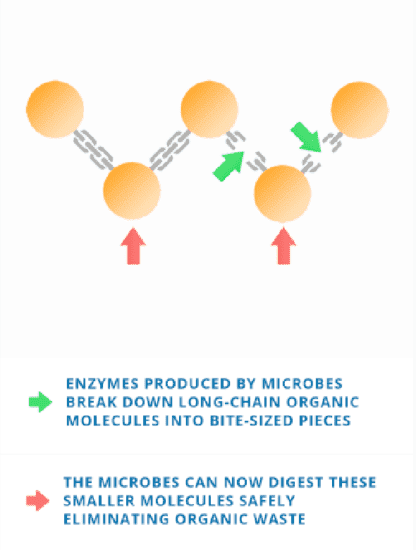
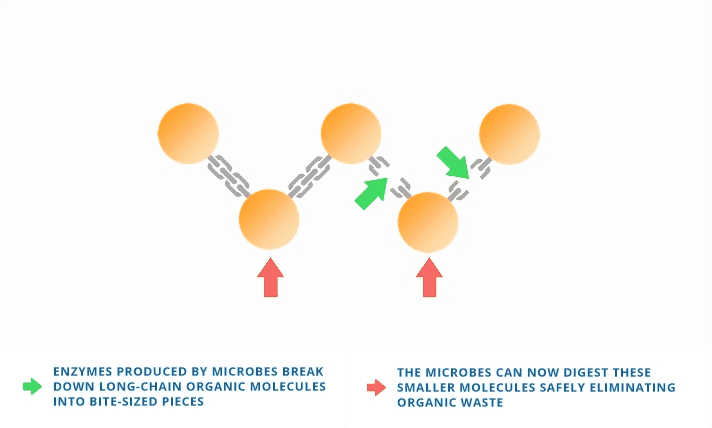
Why are Microbes Important in Your Septic System?
Microbes and bacteria are essential in your septic tank and aid the purification process. They are required to break down the organic waste and solids that sink to the bottom of your tank and ensure that your septic system is in prime working order.
